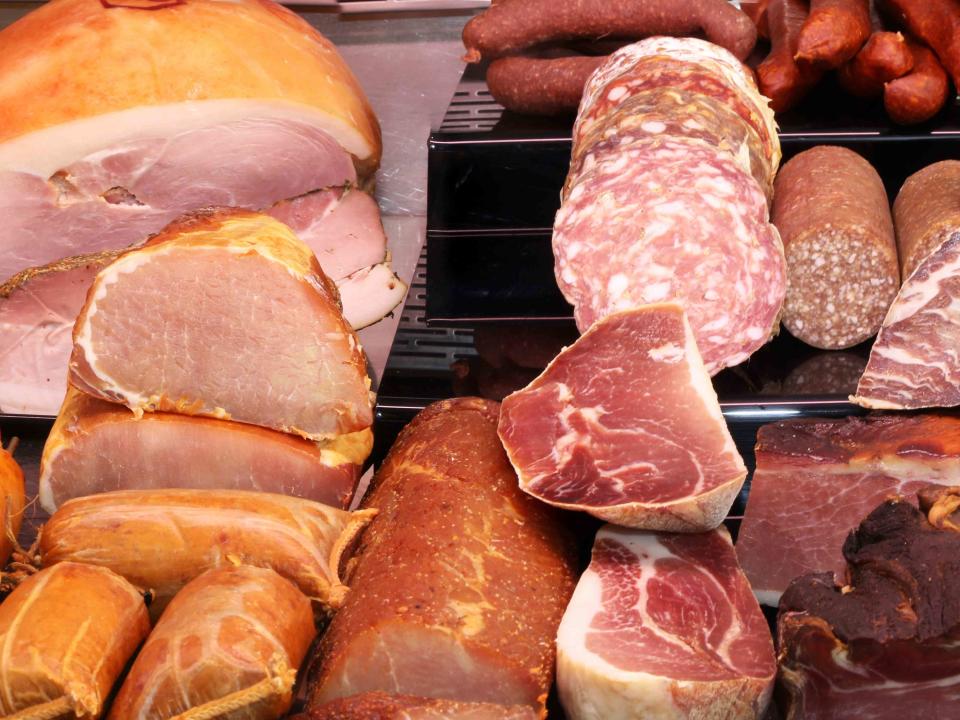Why Does My Deli Meat Look… Rainbow? And Is It Safe to Eat?
Here’s what to know before you toss out another sandwich.

U.J. Alexander/Getty Images
Have you ever opened the fridge to make a sandwich, only to find that your sliced deli meats resemble the Rainbow Fish?
That pearly iridescence you’d recognize on a sidewalk after a rain storm, on the bottom side of a CD, or even on the inside of a seashell, is a whole lot less mesmerizing when it’s coloring your roast beef.
You probably think to yourself, "I just bought this meat three days ago. Has it gone bad already?"
Stop right there—and don’t say goodbye to your sandwich. We get why you might find multi-colored meats alarming (even frightening), but as it turns out, there’s a perfectly natural explanation for the strange sheen.
Why Does Meat Look Rainbow?
Although a "beef rainbow" might look supernatural, it’s totally normal. Stick with us for a brief science lesson here.
A piece of meat is made up of tightly packed strands of fibers. Deli meat is usually sliced perpendicular to those fibers (or against the grain) for the most tender and easy-to-chew cuts, especially when it comes to tougher pieces of meat like roast beef and brisket.
When those fibers are shredded, especially after the meat has been cooked or cured, the severed ends create rigid grooves. When white light from the atmosphere bounces off those grooves, it is reflected back at different angles (creating different colors) in a phenomenon known as a "diffraction grating."
So, that refraction of light, paired with natural moisture and oils on the surface of the meats, creates what you see: a mesmerizing display of color waves.
This iridescence only occurs in whole cuts of meat (or solid muscle tissues), so it won’t be spotted in ground or restructured meats, like sausage. Additionally, it's hard to spot the effect on turkey or chicken slices, not because the same light-bending process doesn’t take place, but because the meat is too pale for the eye to detect it.
Is Rainbow Meat Safe to Eat?
While the metallic meat might look rancid, it’s just a trick of the eye. There’s no safety risk in eating cold cuts with a little bit of shine, and you won’t find any effect on the taste either (so long as the meat is otherwise fresh).
However, the colorful gleam is often seen as unacceptable to consumers and assumed to be a sign of spoilage (especially when a green hue is present). Sadly, this misconception can lead to a huge amount of unnecessary food waste.
As long as the meat is consumed before the expiration date, there’s no reason for concern. According to the USDA, “Spoiled cooked beef would probably also be slimy or sticky and have an off-odor.”
How Do You Prevent Rainbow Meat?
Because the metallic effect doesn’t impact flavor or safety, it doesn’t need to be prevented at all. In fact, it’s somewhat challenging to avoid according to a study published by the Meat Science Department of Ohio State University.
But, if you’re turned off by the shimmery sight, there are some ways around it.
The multi-colored glimmer is most obvious on very smooth cuts of meat (for example, the kinds of cuts a super sharp, commercial-grade meat slicer would make). If you slice meat with a blunt-edge knife, the rainbow effect is less likely to appear.
Chicken, turkey, and other light-colored cold cuts are also less likely to have rainbow colors, as the sheen is most visible on dark meats. You can also opt for ground or restructured meats (like salami and bologna) which won’t display the holographic shine.
Regardless, the rainbow luster is nothing to be wary of. So, don’t skip out on your favorite sandwich just because it has a little shimmer—slap on some mayo and enjoy!

